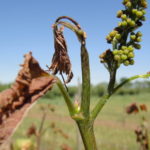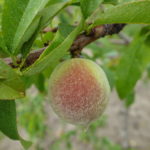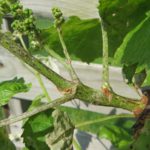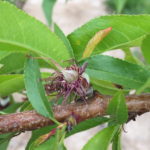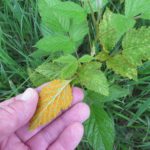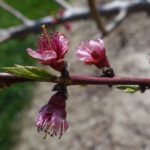Growers across the state experienced some damage from frost and freeze events on May 7, 8, and 9. Damage is scattered across the state and ranges from minor to severe. We did not have damage in the Lafayette area, but areas of northern and northeastern Indiana were hit. Surprisingly some damage occurred in south central[Read More…]
Grapes are at the 8-10 inch shoot stage in southern Indiana and 6 inches or less in northern Indiana. Brambles are blooming in the south and approaching first bloom in central and northern areas. Blueberries are at petal fall to full bloom across the state. There are a few reports of damage to grapes and[Read More…]
One of the most critical management practices for grapes is crop load management through shoot and cluster thinning. Many varieties grown in Indiana tend to produce a large number of “non-count” shoots from adventitious buds and basal buds at count nodes. This can lead to excess crop and shading in the canopy. In addition, some[Read More…]
WASHINGTON, Mar. 15, 2017 –America’s farmers and ranchers will soon have the opportunity to strongly represent agriculture in their communities and industry by taking part in the 2017 Census of Agriculture. Conducted every five years by the U.S. Department of Agriculture’s (USDA) National Agricultural Statistics Service (NASS), the census, to be mailed at the end[Read More…]
The weather the past 3 weeks has been ideal for development of Phomopsis cane and leaf spot. Temperatures have been cool with frequent rain, and shoot growth has been slow. These conditions favor sporulation and infection by Phomopsis viticola. This pathogen is one of the major causes of fruit rot in the Midwest. Early season[Read More…]
Grapes have grown quickly this past week and most varieties are now past bud burst. The earliest have 4 to 6 inch shoots at this time. Blackberries and raspberries are also growing rapidly, with new primocanes emerging from the ground and laterals on floricanes out to 4 inches or longer. Flower buds are visible on[Read More…]
Grape growth is a bit ahead of normal this year. Grapes are at the critical early shoot growth stage when Phomopsis cane and leaf spot infections occur. This is a critical time to take preventative control measures for this disease. If left unchecked, the early shoot infections will spread to cluster stems and developing berries.[Read More…]
Orange rust is one of the most common diseases of blackberries and black raspberries in the Midwest. It is a systemic disease that is confined to Rubus spp. (autoecious). There are two forms, a long-cycle form that occurs on black raspberry, and a short-cycle form that occurs on blackberries. There are two causal organisms: Arthuriomyces[Read More…]
The 2017 growing season has officially started as vines are budding out. As we go through the next couple of weeks, it is important to realize that some potential pest and disease problems require early season sprays. The first is Phomopsis, a major problem on many grape varieties in the Midwest. Mancozeb should be applied[Read More…]

